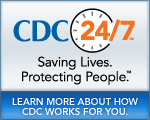MMWR
Morbidity and Mortality Weekly Report
MMWR News Synopsis for October 16, 2008
- (Box) National Teen Driver Safety Week a€“ October 19-25, 2008
- Injuries Resulting From "Car Surfing" a€“ United States, 1990-2008
- Illnesses and Injuries Related to Total Release Foggers a€“ Eight States, 2001-2006
There will be no MMWR telebriefing scheduled for:
October 16, 2008 at 12 p.m. ET
(Box) National Teen Driver Safety Week
PRESS CONTACT: CDC
Division of Media Relations
(404) 639-3286
No Summary Available.
Injuries Resulting From "Car Surfing" a€“ United States, 1990-2008
PRESS CONTACT: National Center for Injury Prevention and Control Media Line
(770) 488-4902
Parents, educators, and health-care providers should be aware of the dangers of car surfing, whichcan lead to injury or death at nearly any speed. ??A review of newspapers stories indicates that since 1990, at least 99 people have died or been seriously injured as a result of car surfing a€“ an activity practiced mainly by teens which involves riding on the exterior of a moving vehicle while it is being driven by another person.??Car surfing fatalities have been reported to have occurred at a range of vehicle speeds, from five to 80 mph. with sudden maneuvers, such as braking or swerving, sometimes making even slow speeds very dangerous. CDC researchers analyzed newspaper stories in LexisNexis?? obtained from 1990 through 2008. Although car surfing injuries are not as frequent as many other motor vehicle injuries, they can be extremely serious and even deadly. This severity raises the importance of preventing car surfing injuries and convincing teens that they should never engage in this risky behavior.
Illnesses and Injuries Related to Total Release Foggers
PRESS CONTACT: Fred Blosser
National Institute for Occupational Safety and Health, Public Affairs Officer
(202) 245-0645
Total-Release Foggers (TRFs) pose a risk for acute, usually temporary health effects among users and bystanders. The most effective way to reduce the risk of occupational or residential health effects from TRFs and other pesticides is to minimize the need for use of these and other pesticide products by using integrated pest management control strategies that prevent insects from entering homes and workplaces. Concepts of integrated pest management control that should be promoted and adopted include eliminating the pestsa€? access to food, water and shelter. Because TRFs are often used by consumers as a low cost alternative to professional pest control services, the hazards and proper use of TRFs need to be better communicated on the TRF label and in public media campaigns. During 2001-2006, 466 cases of acute pesticide-related illness/injury associated with exposure to insecticides from total-release foggers or "bug bombs" occurred in eight states, resulting in cough, shortness of breath and upper airway irritation as the most common symptoms. The preventable TRF exposures sometimes occurred in workplaces but predominantly in homes and were often due to inability or failure to vacate before the TRF discharged, reentry into the treated space too soon after the TRF was discharged, excessive use of TRFs for the space being treated, accidental discharge of a TRF and failure to notify others nearby.
####
- Page last reviewed: October 16, 2008
- Page last updated: October 16, 2008
- Content source: Office of Enterprise Communication
- Notice: Links to non-governmental sites do not necessarily represent the views of the CDC.
View Press Releases in
Get e-mail updates
To receive e-mail updates about this page, enter your
e-mail address:
Contact Us:
- Centers for Disease Control and Prevention
1600 Clifton Rd
Atlanta, GA 30333 - 800-CDC-INFO
(800-232-4636)
TTY: (888) 232-6348 - Contact CDC-INFO


